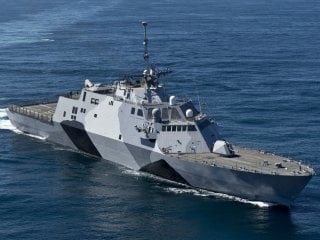The Navy Wants More Littoral Combat Ships to Hunt Enemy Submarines
Plans for the ship have evolved over the years as it was initially conceived of as purely a shallow-draft ship intended for coastal or littoral regions.
Here's What You Need to Remember: Despite some of these movements, the Navy has continued to pursue its fleet of emerging LCS ships and worked to preserve and evolve its combat efficacy. These efforts have included arming the ship with deck-launched Hellfire missiles and integrating longer-range strike missiles into the ship.
The U.S. Navy is adding more Littoral Combat Ships (LCS) to the fleet to further strengthen its submarine-hunting capabilities. The LCS are also being equipped with upgraded weapons for countermine, surface warfare and surveillance missions needed for major, great power warfare.
The Navy has now commissioned its 22nd Littoral Combat Ship, the USS St. Louis, as part of a broader move to further strengthen the warfare technologies of the surface fleet.
“St. Louis is the 22nd LCS to be delivered to the Navy, and the tenth of the Freedom-variant to join the fleet,” a Navy statement said.
Plans for the ship have evolved over the years as it was initially conceived of as purely a shallow-draft ship intended for coastal or littoral regions. With the advent of a great-power warfare competition era, Navy strategists have reconfigured the mission scope for the ship and armed it with over-the-horizon missiles and emerging submarine and mine hunting systems.
The ship’s shallow draft allows it to hunt submarines, mines and enemy targets in areas not deep enough for deeper draft ships. This enables coastal patrol and reconnaissance missions as well as a close-in mine-hunting ability.
As part of this mission set, the LCS is increasingly being engineered with surface and undersea drones to hunt mines, conduct surveillance and lower submarine-hunting sonar into the water.
“When the USS St. Louis is paired with world’s most advanced maritime helicopter, the MH-60R, it will have a robust anti-submarine mission capability,” the Navy report says.
The ship’s forty-knot speed, advanced submarine hunting technology and additional weapons are variables expected to greatly improve the ship’s ability to perform deep-water missions.
Several years ago, some observers, critics and members of Congress made the argument that the ship was not survivable enough for major-power, “blue-water” warfare, inspiring a Pentagon effort to reduce the fleet of planned LCS ships and engineer a new, more heavily armed Frigate ship.
However, despite some of these movements, the Navy has continued to pursue its fleet of emerging LCS ships and worked to preserve and evolve its combat efficacy. These efforts have included arming the ship with deck-launched Hellfire missiles and integrating longer-range strike missiles into the ship.
The Navy has made particular efforts, in fact, to integrate Hellfire technology, sensors and fire control with other assets woven into the LCS. Not only could an MH-60R offer a laser spot for the ship-launched weapon, but the helicopter can fire Hellfire missiles itself.
A ship-launched variant, however, would need to further integrate with ship-based layered defense technologies to optimize its attack options against enemy aircraft and ships, particularly in a maritime combat environment potentially more difficult for helicopters to operate in.
This would include engineering the ship to operate as part of a broader ship-wide technical system connecting things like variable-depth sonar, deck guns, vertical take-off drones such as the Fire Scout and small boat mission capabilities such as eleven-meter Rigid Inflatable Boats (RIBs). The Surface Warfare Mission Package also includes the Gun Mission Module, containing 30mm guns, Navy statements say. As part of this, the LCS is equipped with a 57mm gun, .50-cal Machine Guns and a defensive interceptor missile called SeaRAM.
Kris Osborn is defense editor for the National Interest. Osborn previously served at the Pentagon as a Highly Qualified Expert with the Office of the Assistant Secretary of the Army—Acquisition, Logistics & Technology. Osborn has also worked as an anchor and on-air military specialist at national TV networks. He has appeared as a guest military expert on Fox News, MSNBC, The Military Channel, and The History Channel. He also has a Masters Degree in Comparative Literature from Columbia University. This first appeared in 2018 and is being reposted due to reader interest.
Image: Wikipedia.

